Kosaraju's AlgorithmIn the following tutorial, we will learn about the formation of strongly connected components and finding them using Kosaraju's Algorithm. We will also understand some working examples of Kosaraju's Algorithm in different programming languages like C++ and Python. But before we get started, let us briefly understand what Strongly Connected Components (SCC) are. Understanding the Strongly Connected ComponentsA Directed Graph is said to be strongly connected if there exists a path in each direction of each pair of nodes (or vertices) of the graph. This statement implies a path from the first node in the pair to the second and another path from the second node to the first. In a directed graph G that may not be strongly connected, a pair of nodes N and M are said to be strongly connected to each other if a path exists in each direction between them. The binary relation of being strongly connected is considered an equivalence relation, and the induced subgraphs of its equivalence classes are known as Strongly Connected Components (abbreviated as SCC). Equivalently, a strongly connected component of a directed graph G is a sub-graph that is strongly connected and is maximal with this property: no additional nodes or edges from G can be comprised in the sub-graph without violating its property of being strongly connected. The group of strongly connected components forms a partition of the set of nodes of G. A strong, connected component (SCC) is considered trivial if it contains a single node that is not connected to itself with an edge; otherwise, it is known as non-trivial. We will now understand the above context with the help of an example: Let us consider the graph shown below: 
Figure 1: An Initial Directed Graph The strongly connected components of the above graph will be: 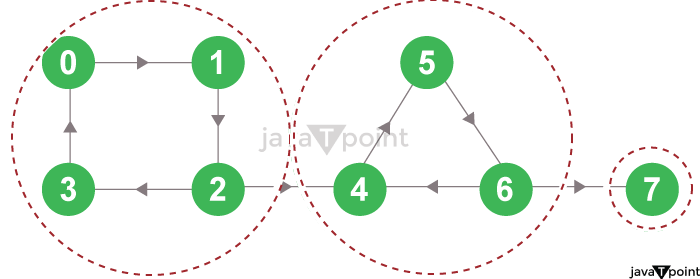
Figure 2: The Strongly Connected Components of the Directed Graph As we can observe from the above figure, every node in the first strongly connected component reaches the other vertex through the directed path. And similar observations can be drawn for the second and third strongly connected components. We can find these components using Kosaraju's Algorithm. Understanding the Kosaraju's AlgorithmKosaraju's Algorithm is centred on twice implementation of the depth-first search algorithm. The complete procedure of this algorithm is divided into steps discussed below: Step 1: Firstly, we will perform a depth first search on the complete graph. We will start from node A, visit all its child nodes, and mark the selected node as visited. If the node leads to an already visited node, we will push the current node to the stack. 
Figure 3.1: A Given Graph For instance, in the given graph, we will start from node 0, visit node 1, node 2, and then node 3. Since node 3 leads to an already visited node, i.e., node 0, we will push the source node (i.e., node 3) into the stack. 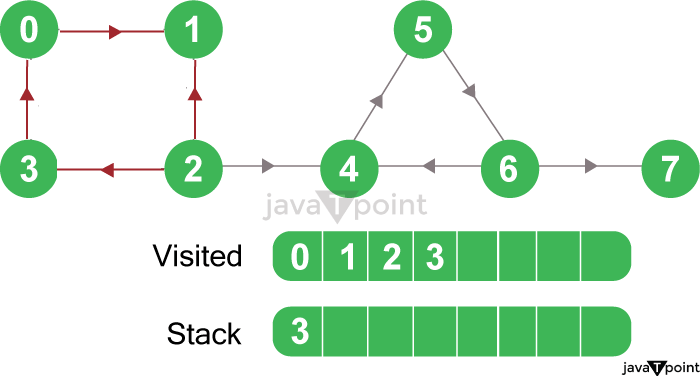
Figure 3.2: DFS on the Graph We will then go to the previous node and visit its unvisited child nodes, i.e., node 4, node 5, node 6, and node 7, sequentially. Since we can't go anywhere from node 7, we will push it into the stack. 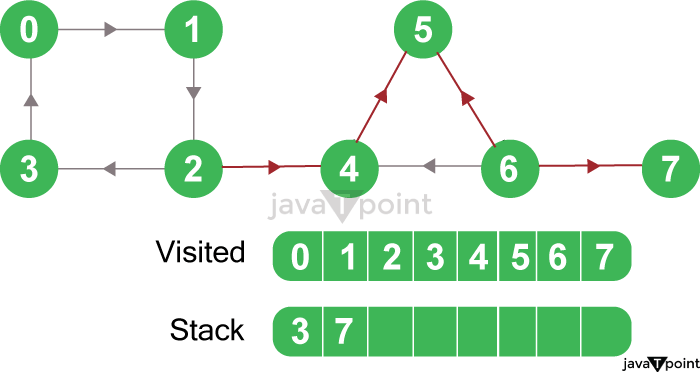
Figure 3.3: DFS on the Graph We will now return to the previous node (i.e., node 6) and visit its child nodes. However, we will push it into the stack since all of its child nodes are already visited. 
Figure 3.4: Stacking In the similar way, a final stack is created. 
Figure 3.5: Final Stack Step 2: Reversing the Original Graph 
Figure 3.6: DFS on Reversed Graph Step 3: Performing Depth-First Search on the Reversed Graph We will now start from the top node of the stack and traverse through all its child nodes. Once the already visited node is reached, one strongly connected component is formed. For instance, we will pop node 0 from the stack. Starting from node 0, we will traverse through its child nodes (node 0, node 1, node 2, node 3 in sequence) and mark them as visited so these visited nodes form one strongly connected component. 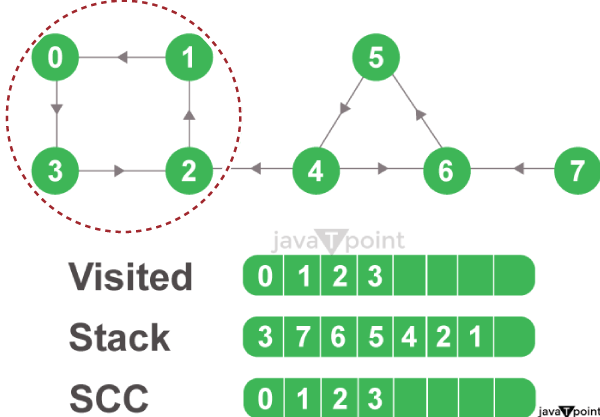
Figure 3.7: Start from Top and Traverse through All the Nodes We will now go to stack and start popping the top node if it is already visited. Otherwise, we will select the top node from the stack and start traversing through its child nodes, as presented in the given figures. 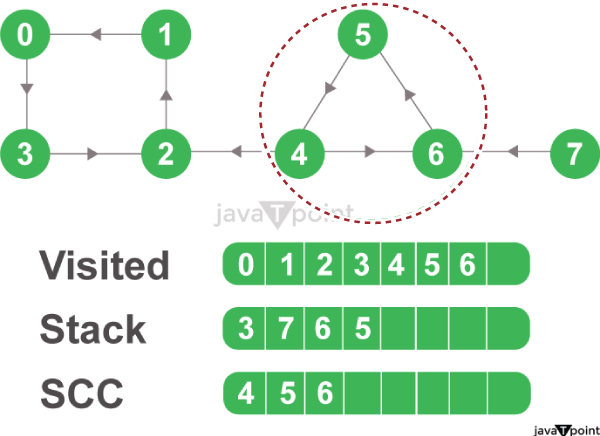
Figure 3.8: Pop the Top Node if Already Visited 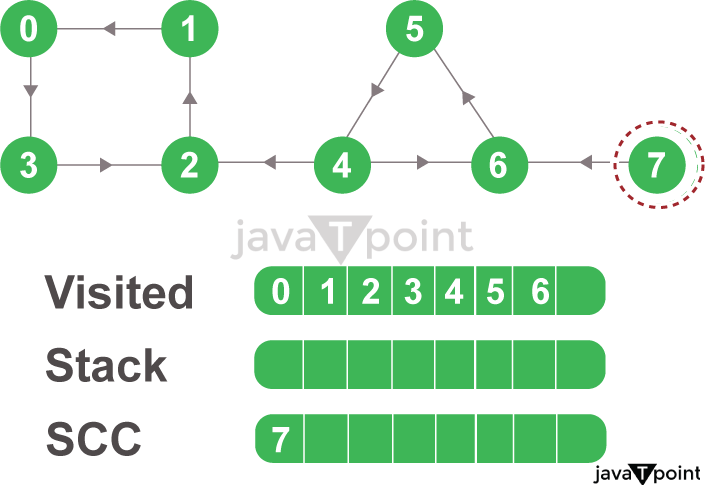
Figure 3.9: Strongly Connected Component Step 4: Hence, the strongly connected components of the graph are as follows: 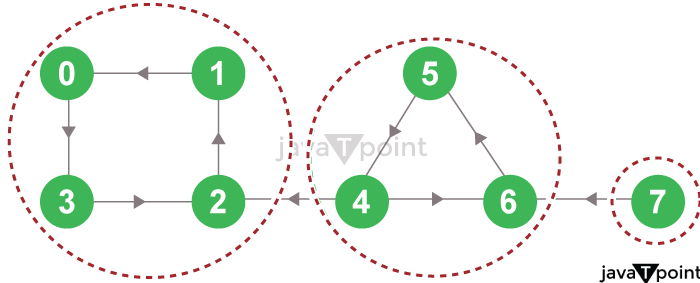
Figure 3.10: All Strongly Connected Components Implementation of Kosaraju's Algorithm in Different Programming LanguagesNow that we have successfully understood the concepts and working of Kosaraju's Algorithm, it is time to see its implementation in different programming languages like C++, and Python. Code for Kosaraju's Algorithm in C++The following is the implementation of Kosaraju's Algorithm in the C++ Programming Language: File: example.cpp Output: The Strongly Connected Components of the Graph : 0 3 2 1 4 6 5 7 Explanation: In the above snippet of code, we have included the required header files and used the standard namespace. We then defined a class as DirectedGraph. Inside this class, we have defined some variables and methods to serve different purposes in the program. We then defined a constructor to create a graph for the number of nodes. We have also defined the method to perform the depth-first search, where we will visit all the child nodes of the selected node and mark them visited. We then defined the method to transpose the nodes of the graph to reverse its order. We have also defined the method to add edges between the nodes to represent the directions in the graph. After that, we have defined the method to push the current node into the stack if it leads to visited nodes. We have also defined the method to print all the strongly connected components of the graph for the users. For the main function, we have instantiated the DirectedGraph() class and used its add_edge() method to add different edges to the graph. At last, we have printed a statement for the users and called the print_strongly_connected_components() method to print all the strongly connected components of the graph. As a result, all the possible strongly connected components of the graph are printed for the users. Code for Kosaraju's Algorithm in PythonThe following is the implementation of Kosaraju's Algorithm in the Python Programming Language: File: example.py Output: The Strongly Connected Components of the Graph : 0 3 2 1 4 6 5 7 Explanation: In the above snippet of code, we have imported defaultdict class from the collections library and defined a class as DirectedGraph. Inside this class, we have defined an initializing method to define and initialize some variables required in the program. We have then defined the method to add edges between the nodes to represent the directions in the graph. We have also defined the method to perform the depth-first search, where we will visit all the child nodes of the selected node and mark them visited. After that, we have defined the method to push the current node into the stack if it leads to visited nodes. We have also defined the method to transpose the nodes of the graph to reverse its order and the method to print all the strongly connected components of the graph for the users. For the main function, we have instantiated the DirectedGraph() class and used its addEdge() method to add different edges to the graph. At last, we have printed a statement for the users and called the printStronglyConnectedComponents() method to print all the strongly connected components of the graph. As a result, all the possible strongly connected components of the graph are printed for the users. Understanding the Time and Space Complexity of Kosaraju's AlgorithmTime Complexity: In Kosaraju Algorithm, there are mainly three steps that take place:
Therefore, the total time taken to perform the above three steps in Kosaraju's Algorithm will be: O(V + E) + O(V) + O(V + E) = O(V + E) Hence, the time complexity of Kosaraju's Algorithm is O(V + E), where V is the number of nodes and E is the number of edges in the graph Space Complexity: Since Kosaraju's Algorithm uses a stack to store the nodes while performing the first Depth-First Search (DFS), thus the space utilized by the stack will be equal to the size of the nodes of the graph. Therefore, the space complexity of Kosaraju's Algorithm is O(N), where N is the number of nodes in the graph. Advantages and Disadvantages of Kosaraju's Algorithm
Applications of Strongly Connected ComponentsThe following are some applications of Strongly Connected Components:
Alternatives of Kosaraju's AlgorithmIn addition to Kosaraju's Algorithm, there are some other algorithms that are used to find strongly connected components in a directed graph. Some examples of such algorithms are Tarjan's Algorithm and the Path-Based Strong Component Algorithm.
The Conclusion
Next TopicFloyd-Warshall Algorithm
|
 For Videos Join Our Youtube Channel: Join Now
For Videos Join Our Youtube Channel: Join Now
Feedback
- Send your Feedback to [email protected]
Help Others, Please Share










